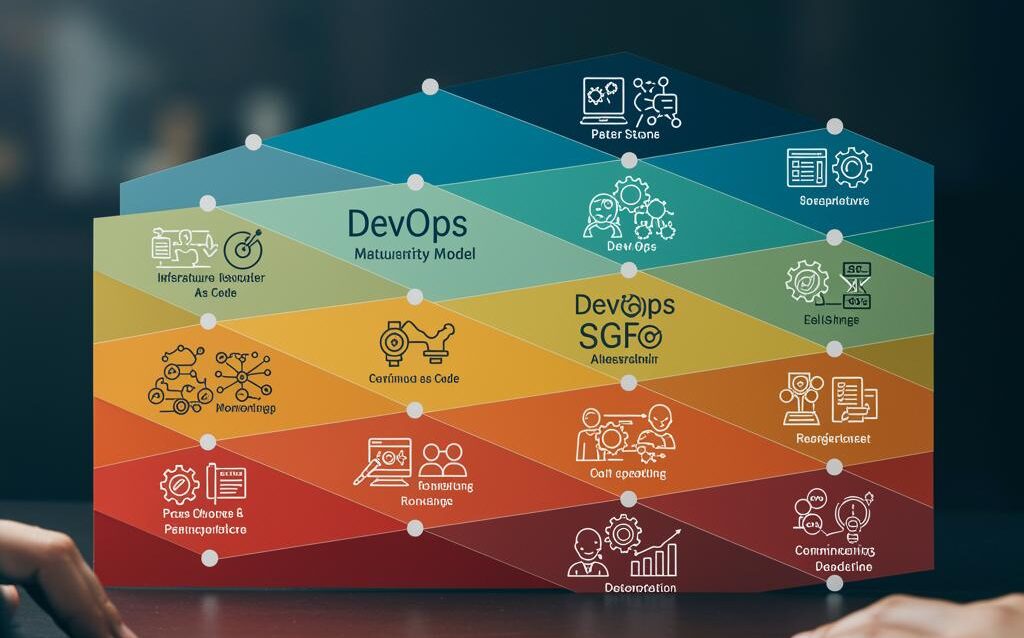DevOps Maturity Model: Assess & Level Up Your Processes
DevOps Maturity Model: Assessing and Improving Your Processes
DevOps, a cultural and technical movement, aims to streamline software development and deployment. However, adopting DevOps isn’t a simple switch; it’s a journey. A DevOps Maturity Model provides a framework to assess your current state, identify areas for improvement, and guide your evolution towards a high-performing DevOps organization.
Understanding DevOps Maturity Models
A DevOps Maturity Model is a structured set of criteria that defines different levels of DevOps adoption within an organization. Each level represents increasing sophistication in automation, collaboration, and overall efficiency. These models help you:
- Identify Your Current State: Determine where your organization stands in its DevOps journey.
- Pinpoint Bottlenecks: Uncover areas hindering your development and deployment pipelines.
- Prioritize Improvements: Focus on the most impactful changes to accelerate your DevOps evolution.
- Measure Progress: Track your improvements and demonstrate the value of your DevOps initiatives.
While various models exist (e.g., the CMMI Institute’s DevOps Maturity Model, the XebiaLabs DevOps Periodic Table), they generally share common dimensions, such as:
- Culture: Collaboration, communication, trust, and shared responsibility.
- Automation: Infrastructure as Code (IaC), Continuous Integration/Continuous Delivery (CI/CD), automated testing.
- Measurement: Monitoring, logging, analytics, and feedback loops.
- Lean Principles: Eliminating waste, optimizing workflow, and continuous improvement.
- Sharing: Knowledge sharing, documentation, and community involvement.
Assessing Your Current DevOps Maturity
Before embarking on any improvement initiatives, you need a clear understanding of your current state. A thorough assessment involves examining your practices across the key dimensions of a DevOps Maturity Model.
Conducting a Self-Assessment
Start by conducting a self-assessment using a standardized questionnaire or checklist based on a selected maturity model. Consider these questions:
- Culture: How well do development and operations teams collaborate? Is there a culture of blameless postmortems?
- Automation: What percentage of your infrastructure is managed as code? How automated is your deployment pipeline?
- Measurement: What key metrics are you tracking? How effectively are you using data to drive improvements?
- Lean Principles: How do you identify and eliminate waste in your processes? How frequently do you release software?
- Sharing: How well is knowledge shared across teams? Is your documentation up-to-date and accessible?
Gathering Data and Insights
Supplement your self-assessment with data from various sources:
- Surveys: Collect feedback from team members across development, operations, and security.
- Interviews: Conduct interviews with key stakeholders to gain deeper insights into their perspectives.
- Process Analysis: Analyze your current workflows to identify bottlenecks and inefficiencies.
- Tooling Audit: Evaluate your existing tools and identify gaps in your automation capabilities.
Compile the data and create a clear picture of your organization’s strengths and weaknesses across the DevOps dimensions. Visualize the results to facilitate communication and alignment.
Improving Your DevOps Processes: A Step-by-Step Approach
Once you have a solid understanding of your current state, you can develop a roadmap for improvement. Focus on incremental changes and prioritize initiatives that will deliver the greatest impact.
Phase 1: Foundational Practices
Address the fundamental building blocks of DevOps:
- Establish Cross-Functional Teams: Break down silos between development, operations, and security.
- Implement Version Control: Manage all code, configuration, and infrastructure as code in a version control system.
- Automate Infrastructure Provisioning: Use tools like Terraform or Ansible to automate infrastructure creation and management.
- Implement Continuous Integration: Automate the build, test, and integration of code changes.
Phase 2: Expanding Automation and Collaboration
Build upon the foundational practices to further automate and improve collaboration:
- Implement Continuous Delivery: Automate the deployment of code changes to staging and production environments.
- Automate Testing: Implement automated testing at all stages of the development lifecycle.
- Improve Monitoring and Logging: Implement comprehensive monitoring and logging to gain visibility into system performance.
- Establish Feedback Loops: Implement mechanisms for gathering and acting on feedback from users and stakeholders.
Phase 3: Optimization and Continuous Improvement
Focus on optimizing processes and fostering a culture of continuous improvement:
- Implement Lean Principles: Identify and eliminate waste in your processes.
- Automate Release Management: Streamline the release process and reduce the risk of errors.
- Implement Self-Healing Infrastructure: Automate the detection and resolution of infrastructure issues.
- Foster a Culture of Learning: Encourage experimentation, learning, and knowledge sharing.
Measuring and Tracking Progress
Regularly track your progress against your DevOps Maturity Model to ensure that your initiatives are delivering the desired results. Define key performance indicators (KPIs) to measure your progress across the key dimensions of DevOps.
Examples of KPIs include:
- Deployment Frequency: How often are you deploying software to production?
- Lead Time for Changes: How long does it take to get a code change into production?
- Mean Time to Recovery (MTTR): How long does it take to recover from a service outage?
- Change Failure Rate: What percentage of deployments result in a failure?
- Customer Satisfaction: How satisfied are your customers with your software?
Regularly review your KPIs and adjust your roadmap as needed. Celebrate successes and learn from failures. Continuous improvement is a key principle of DevOps.
Conclusion
The DevOps Maturity Model provides a valuable framework for assessing and improving your DevOps processes. By understanding your current state, identifying areas for improvement, and tracking your progress, you can accelerate your DevOps journey and achieve significant benefits, including faster release cycles, improved quality, and increased customer satisfaction. Remember that DevOps is a journey, not a destination. Embrace continuous improvement and adapt your approach as your organization evolves.

